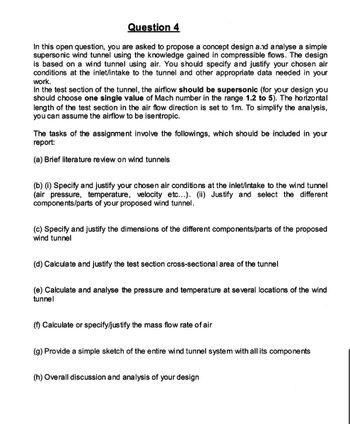
Elements Of Electromagnetics
7th Edition
ISBN: 9780190698614
Author: Sadiku, Matthew N. O.
Publisher: Oxford University Press
expand_more
expand_more
format_list_bulleted
Question
I need help on 4b

Transcribed Image Text:Question 4
In this open question, you are asked to propose a concept design and analyse a simple
supersonic wind tunnel using the knowledge gained in compressible flows. The design
is based on a wind tunnel using air. You should specify and justify your chosen air
conditions at the inlet/intake to the tunnel and other appropriate data needed in your
work.
In the test section of the tunnel, the airflow should be supersonic (for your design you
should choose one single value of Mach number in the range 1.2 to 5). The horizontal
length of the test section in the air flow direction is set to 1m. To simplify the analysis,
you can assume the airflow to be isentropic.
The tasks of the assignment involve the followings, which should be included in your
report:
(a) Brief literature review on wind tunnels
(b) (i) Specify and justify your chosen air conditions at the inlet/intake to the wind tunnel
(air pressure, temperature, velocity etc...). (ii) Justify and select the different
components/parts of your proposed wind tunnel.
(c) Specify and justify the dimensions of the different components/parts of the proposed
wind tunnel
(d) Calculate and justify the test section cross-sectional area of the tunnel
(e) Calculate and analyse the pressure and temperature at several locations of the wind
tunnel
(f) Calculate or specify/justify the mass flow rate of air
(g) Provide a simple sketch of the entire wind tunnel system with all its components
(h) Overall discussion and analysis of your design
Expert Solution
This question has been solved!
Explore an expertly crafted, step-by-step solution for a thorough understanding of key concepts.
Step by stepSolved in 2 steps

Knowledge Booster
Learn more about
Need a deep-dive on the concept behind this application? Look no further. Learn more about this topic, mechanical-engineering and related others by exploring similar questions and additional content below.Similar questions
- Water is flowing through a 15-cm-diameter pipe that consists of a 3-m-long vertical and 2-m-long horizontal section with a 90° elbow at the exit to force the water to be discharged downward, as shown in Fig. P6–55, in the vertical direction. Water discharges to atmospheric air at a velocity of 5 m/s, and the mass of the pipe section when filled with water is 17 kg per meter length. Determine the moment acting at the intersection of the vertical and horizontal sections of the pipe (point A). What would your answer be if the flow were discharged upward instead of downward?arrow_forwardWhich procedure can be applied to prepare small cooling holes in a turbine blade? Select one: ○ a. SLS O b. CAD ○ c. EDM O d. SEMarrow_forwardA dozer with as S-blade has pushed a normal load onto a level area. The height of this load measured at the inside edge of each track was 7 ft and 7.4 ft. The width of the load at the inside edge of each track was 8.1 ft and 8.4 ft. The greatest length of the pile was 16 ft. What is the capacity of the blade?arrow_forward
Recommended textbooks for you
 Elements Of ElectromagneticsMechanical EngineeringISBN:9780190698614Author:Sadiku, Matthew N. O.Publisher:Oxford University Press
Elements Of ElectromagneticsMechanical EngineeringISBN:9780190698614Author:Sadiku, Matthew N. O.Publisher:Oxford University Press Mechanics of Materials (10th Edition)Mechanical EngineeringISBN:9780134319650Author:Russell C. HibbelerPublisher:PEARSON
Mechanics of Materials (10th Edition)Mechanical EngineeringISBN:9780134319650Author:Russell C. HibbelerPublisher:PEARSON Thermodynamics: An Engineering ApproachMechanical EngineeringISBN:9781259822674Author:Yunus A. Cengel Dr., Michael A. BolesPublisher:McGraw-Hill Education
Thermodynamics: An Engineering ApproachMechanical EngineeringISBN:9781259822674Author:Yunus A. Cengel Dr., Michael A. BolesPublisher:McGraw-Hill Education Control Systems EngineeringMechanical EngineeringISBN:9781118170519Author:Norman S. NisePublisher:WILEY
Control Systems EngineeringMechanical EngineeringISBN:9781118170519Author:Norman S. NisePublisher:WILEY Mechanics of Materials (MindTap Course List)Mechanical EngineeringISBN:9781337093347Author:Barry J. Goodno, James M. GerePublisher:Cengage Learning
Mechanics of Materials (MindTap Course List)Mechanical EngineeringISBN:9781337093347Author:Barry J. Goodno, James M. GerePublisher:Cengage Learning Engineering Mechanics: StaticsMechanical EngineeringISBN:9781118807330Author:James L. Meriam, L. G. Kraige, J. N. BoltonPublisher:WILEY
Engineering Mechanics: StaticsMechanical EngineeringISBN:9781118807330Author:James L. Meriam, L. G. Kraige, J. N. BoltonPublisher:WILEY

Elements Of Electromagnetics
Mechanical Engineering
ISBN:9780190698614
Author:Sadiku, Matthew N. O.
Publisher:Oxford University Press

Mechanics of Materials (10th Edition)
Mechanical Engineering
ISBN:9780134319650
Author:Russell C. Hibbeler
Publisher:PEARSON

Thermodynamics: An Engineering Approach
Mechanical Engineering
ISBN:9781259822674
Author:Yunus A. Cengel Dr., Michael A. Boles
Publisher:McGraw-Hill Education

Control Systems Engineering
Mechanical Engineering
ISBN:9781118170519
Author:Norman S. Nise
Publisher:WILEY

Mechanics of Materials (MindTap Course List)
Mechanical Engineering
ISBN:9781337093347
Author:Barry J. Goodno, James M. Gere
Publisher:Cengage Learning

Engineering Mechanics: Statics
Mechanical Engineering
ISBN:9781118807330
Author:James L. Meriam, L. G. Kraige, J. N. Bolton
Publisher:WILEY